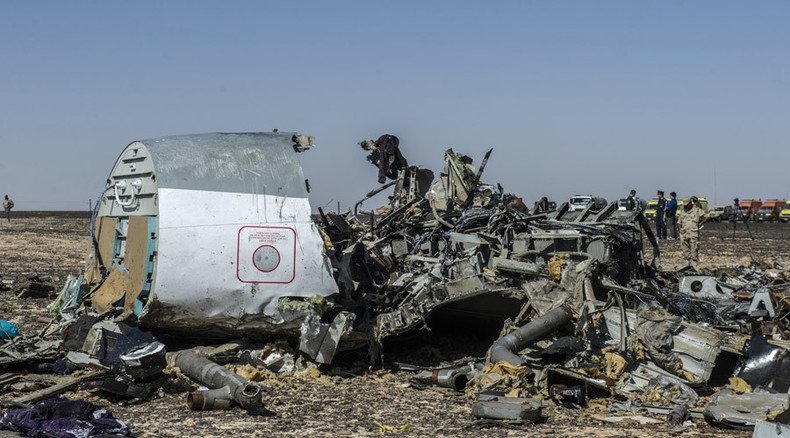Flight 7K9268: What we do and don’t know about Russia’s deadliest-ever air crash

As experts prepare to analyze the flight recorders, the number of theories speculating about the demise of the Russian plane that killed 224 people on Saturday is proliferating by the hour. RT separates the facts from the conjecture.
LIVE UPDATES: Russian passenger jet crash over Sinai: Aftermath, reactions
What was the sequence of events leading up to the tragedy?
The Airbus A321-200 took off from the Egyptian seaside resort of Sharm El-Sheikh at 5:51am local time (3:51 UTC), in the direction of St. Petersburg. Some 22 minutes later, air control, according to local officials, lost contact with the jet, which by then had climbed to 9,450 meters (31,000 feet ).
#7K9268 A321 crash is the deadliest accident involving Airbus A320 family - 224 casualties https://t.co/QRjw5cW9Xkpic.twitter.com/jwLP8qAvNW
— RT (@RT_com) October 31, 2015Flight tracking websites then reported a rapid, almost vertical, descent. The manufacturer Airbus says the plane hit the ground about three minutes later, killing every single person on-board. There was no distress call.
Looping playback of #7K9268. Last data recorded at 04:13:22 UTC https://t.co/RlcJTpDHwIpic.twitter.com/fb2aDxPUBw
— Flightradar24 (@flightradar24) October 31, 2015How did the plane crash?
The head of Russian aviation agency Rosaviatsia, Aleksandr Neradko, has said that “all signs testify to the fact that the destruction of the structure of the airplane took place in the air and at a great altitude.” The principal evidence is that the remains of the plane and the bodies have been scattered over an area measuring about 8 km by 4 km. An Egyptian military source told the media that the plane cracked open into two main segments, one of which collided with a rock on impact.
Why did it crash?
This is the big question, as of now. Islamic State (IS, formerly ISIS/ISIL)-affiliated militants, based in Sinai, stole a march on officials, when they claimed responsibility for the downing of the plane. Russian authorities – backed up by Egyptian officials – have dismissed the boasts as being out of hand, saying the terrorists in the region do not possess the specialized equipment necessary to shoot down a large passenger jet flying at cruising height. Nonetheless, several major carriers have diverted their planes from the route, at least for the time being.
This does not necessarily rule out an act of terror
“Early reports said that the aircraft split into two and that suggests a catastrophic failure, not a mechanical failure, but that suggests perhaps an explosion on board,” posited Michael Clarke, Director General of the Royal United Services Institute, an aviation think tank. “It's much more likely to have been a bomb on board rather than a missile fired from the ground.”
Could a problem with the plane or its crew have caused the disaster?
Some contradictions here. Siberian operator Kogalymavia, also known as Metrojet, has said that a technical malfunction, even one as serious as an engine fire, could not have led to such a rapid disintegration, and Egyptian authorities say the aircraft passed the pre-flight check without incidents.
READ MORE: 10-month girl becomes grieving symbol of Russia tragedy
The Airbus itself was 18 years old – not a particularly grand age by aircraft standards – and had been leased from Aercap, the world’s biggest plane leasing company. It had only suffered one minor incident in 2001.
Debris of crashed Russian #7K9268 A321 in #Sinai (NEW VIDEO) https://t.co/6uqks4XQgupic.twitter.com/aYuliTOSuZ
— RT (@RT_com) November 1, 2015Nonetheless, the wife of one of the co-pilots, told Russian state television that her husband Sergey Trukhachev complained that “the technical condition of the aircraft left much to be desired." The crew itself was very experienced, with pilot Valeriy Nemtsov clocking up over 12,000 hours of flight time prior to the accident.
Metrojet have been told to temporarily ground their planes, while Russian authorities have begun a safety audit of the small company, which is operating five other jets.
When will there be more clarity?
The flight recorders have now been taken to Cairo, with Egyptian officials set to lead the investigation, with the aid of Russian specialists. A team of outside experts has been dispatched by Airbus from France, and two more US investigators will join the analysis, as the engines for the jet were manufactured there. Fragments of the plane will also have to be gathered, meaning that definitive analysis of the causes of the crash are likely to be named after weeks, if not months.












